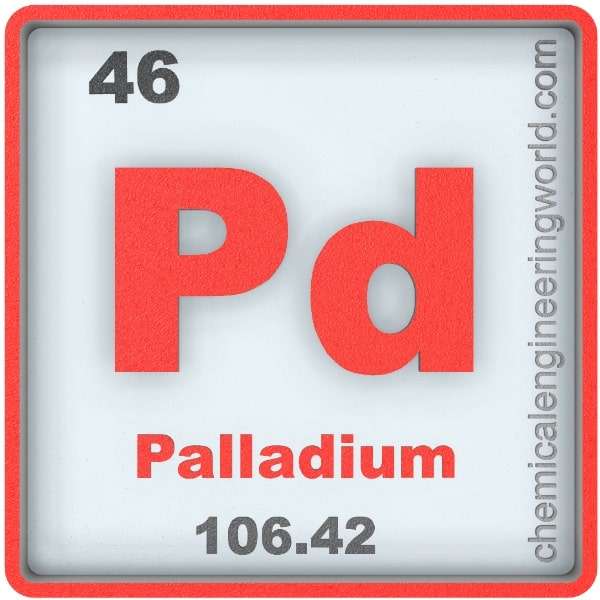Palladium Element Properties and Information

Palladium Element Properties and Information
Palladium is forty-sixth element on the periodic table. Elements are arranged in the periodic table on the basis of the atomic number. Atomic number is the number of protons in the nucleus of the atom. Palladium has an atomic number of 46. It is located in the Group 10 and Period 5 of the periodic table of elements. It is denoted by Pd. The name is given to the element after the asteroid ‘Pallas’.
Palladium was first extracted by William Wollastan in 1803 from platinum ores. He analysed the residue which did not dissolve in aqua-regia and found palladium in it.
Palladium is found in nature in combined and uncombined form. It is mostly found in sulfide minerals such as braggite.
Physical Properties
- Palladium is a soft, silvery-white metal which has close resemblance to platinum.
- The atomic mass of palladium is 106.42
- The melting point of palladium is 1560°C
- The boiling point of palladium is 2927°C
- The density of palladium is 11900 in S.I. units at 20°C
- Palladium has seven naturally occurring isotopes. Six among them are stable.
Chemical Properties
- The most recognized palladium compounds have oxidation state of either 0 or +2.
- Palladium (II) chloride is an example of +2 oxidation state. This compound is notable because it is the principal starting material for most of the palladium based compounds. It is formed when palladium reacts with chlorine.
- Other oxidation states of palladium compounds are quite rare. But some compounds have been reported to have +3,+4, and +6 states. Also, mixed valent compounds of palladium are also known.
Methods of Production
- Electrolysis: Although palladium is found in free state, mostly in ores where gold is present; commercially it is obtained as a by-product from nickel-copper processing just like ruthenium and rhodium.
- Nuclear fission: Palladium is produced as one of the fission products during nuclear reaction. It is possible to extract it from the spent nuclear fuel, but palladium obtained from such source is not used commercially.
Relevance in Chemical and Related Industries
- Catalyst: The most important use of palladium is as versatile catalysts. Some reactions which use palladium compound catalysts are; Heck reaction, Suzuki coupling, Wacker process, Negishi reaction, etc.
- Hydrogen production: Hydrogen diffuses very easily through palladium, thus palladium is applied as membranes in membrane reactor technology to recover hydrogen in very high purity.
Relevance in Other Industries
- Electronics: This field observes second greatest use of palladium. It is used in electronics components like capacitors, electrodes, connectors, etc.
- Dentistry: Palladium added to alloys in small quantities is used in the field of dentistry to decrease corrosion in dental amalgam alloys and to increase its lustre.
- Jewelry: Palladium is capable of directly providing the white gold shine without use of rhodium plating in jewellery.
Health Effects on Exposure
- Irritation: The palladium metal itself is low in toxicity also it is poorly absorbed by the body. If contact happens then it is observed to cause minor irritation.
- Palladium compounds: Palladium compounds are regarded to be highly toxic and carcinogenic. They damage the organs if they enter inside the body.
Effects on Surroundings
- Plants: Some plants like water hyacinth are killed by even low level of palladium in soil. Most of the plants are able to survive those low level of palladium in soil but the growth rate gets affected.
References:
https://en.wikipedia.org/wiki/Palladium
https://www.lenntech.com/periodic/elements/pd.htm
































